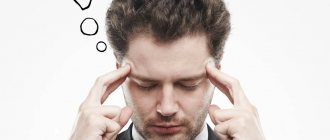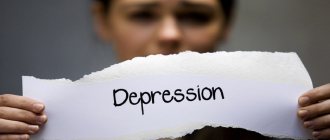Violation of emotional reactions.
Physiological affect is a state of expressed affect (anger), not accompanied by clouding of consciousness, but only by a possible narrowing of the range of ideas concentrating on events associated with the emerging affect;
the episode does not end with sleep, severe psychophysical exhaustion and amnesia. In this state, illegal actions are often committed. These persons are recognized as sane, in contrast to those who have suffered pathological affect. Pathological affect
– a short-term mental disorder with aggressive behavior and an irritable-angry mood against the background of twilight stupefaction. This state occurs in response to intense, sudden mental trauma and is expressed by a concentration of consciousness on traumatic experiences followed by an affective discharge, followed by general relaxation, indifference and, often, deep sleep. Characterized by partial or complete amnesia. Persons who have committed offenses in this state are considered insane.
Disorders of emotional states and properties.
Violation of the expression (strength) of emotions.
- Sensitivity
(emotional hyperesthesia) – increased emotional sensitivity, vulnerability. It may be an innate personality trait, especially pronounced in psychopathy.
- Emotional coldness
– leveling the expression of emotions in the form of an even, cold attitude towards all events, regardless of their emotional significance. Identified in psychopaths and schizophrenia.
- Emotional dullness
– weakness, impoverishment of emotional manifestations and contacts, impoverishment of feelings, reaching the point of indifference. Occurs within the framework of a schizophrenic defect.
- Apathy
- indifference, a complete absence of feelings, in which desires and impulses do not arise. More often there is sensory dullness, in which emotions become dull and poor. The predominant emotion of patients is indifference. It occurs in schizophrenia (defect) and gross organic brain lesions, and can also be a leading manifestation of depressive syndrome.
Apathy
, as a manifestation of depression, is often characterized by a feeling of indifference with a narrowing of the range of interests, or their complete disappearance, a decrease or loss of desires, motivations and needs; patients talk about boredom, laziness, lack of will, mental lethargy, lack of initiative, which is experienced painfully (not depressive apathy is not perceived by patients as something painful and, therefore, does not cause complaints).
Violation of the adequacy of emotions
- Emotional ambivalence
– simultaneous coexistence of antagonistic emotions, causing inconsistency of thinking and inappropriate behavior. A symptom found in schizophrenia.
- Emotional inadequacy
– the emergence of an emotion that does not correspond qualitatively or meaningfully to the stimulus that evokes it, paradoxicality of emotions (a patient with a sad face talks about pleasant impressions). It also occurs in schizophrenia.
Violations of emotional stability.
- Emotional lability
– pathologically unstable mood, which easily changes to the opposite due to changes in the situation. Pathologically unstable mood is characteristic of asthenic syndrome; in addition, it can occur within the framework of emotional-volitional disorders in personality pathology.
- Explosiveness
– increased emotional excitability, in which the experience of frustration, anger, even rage, with aggressive actions easily arises. It may arise for a minor reason. Explosiveness is characteristic of emotional-volitional disorders in personality pathology and organic (traumatic) brain lesions.
- Weakness
- a state of easily fluctuating mood for an insignificant reason from tearfulness to sentimentality with tenderness. May be accompanied by moodiness, irritability, and fatigue. It is observed with vascular damage to the brain, with somatogenic asthenia.
Mood disorders.
Pathologically elevated mood.
- Hyperthymia
– a painfully elevated mood, accompanied by a feeling of joy, strength, and energy (“overflowing gaiety”), sharply reducing the depth and direction of cognitive processes. Hyperthymia is the main symptom of manic syndromes.
- Euphoria -
a painfully elevated mood, accompanied by a feeling of pleasure, comfort, well-being, relaxation, interferes with cognitive processes. Euphoria occurs during intoxication (infectious, alcoholic, etc.).
- Moria
– cheerful excitement with foolishness, childishness, clowning, a tendency to flat and rude jokes; always accompanied by symptoms of intellectual decline. in global dementia.
- Ecstasy
- hyperthymia with a predominance of delight, up to frantic admiration, a feeling of insight, illumination. Often combined with confusion, catatonic manifestations, oneiric stupefaction.
Pathologically low mood.
- Hypotymia
– painfully low mood, experienced as sadness, sadness, despondency, depression, depression, grief, pinching, a feeling of hopelessness, accompanied by a feeling of physical distress, passivity, helplessness, suicidal thoughts and actions. This type of mood disorder is characteristic of depressive syndromes.
2) Dysphoria
– painfully low mood, accompanied by an irritable, melancholy, angry, gloomy feeling. It begins and ends suddenly. May last for hours or days. During dysphoria, patients are prone to aggressive actions. Dysphoria is mainly observed in patients with unfavorable epilepsy, with traumatic and other organic lesions of the brain.
3) Anxiety
– hypothymia combined with the expectation of misfortune and a feeling of internal tension, internal excitement, anxiety, tension, a feeling of languid anticipation of impending trouble, despair, fears for the fate of relatives. Sometimes anxiety is felt physically with a vital tint, like an itch, an internal trembling. Often combined with motor (psychomotor) agitation. As a pathological state, anxiety is irrational and caused by painful mental experiences, and not by real events (“something in the world is about to happen,” the patient tries, for example, to explain his anxiety). Occurs in many acute psychoses (acute paranoid psychoses, stupefaction syndromes), and in depression (anxious depression). Anxious coloring of experiences is characteristic of psychopathological conditions in old age. With neuroses (anxiety disorders), anxiety is less pronounced, there is no pronounced psychomotor agitation and is accompanied by abundant vegetative manifestations (vegetative anxiety).
4) Fear
, as a pathological condition - the experience of momentary danger, with a feeling of an immediate threat to life, well-being, caused by a painful mental state without a real basis. Subjectively, it is difficult to tolerate. It occurs both within the framework of acute psychoses (delusional psychoses, stupefaction syndromes) and with obsessive-compulsive neuroses within the framework of phobias (described above).
Syndromes associated with emotional disorders.
1.Depressive syndrome.
Depression is one of the most common disorders found in both psychiatric and general somatic practice (3-6% in the population).
The basis of the depressive syndrome is the depressive triad
, including: a)
painfully low mood
, b)
ideation
and c
) psychomotor
disturbances in the form of general retardation (although their nature fundamentally depends on the nature of the low mood).
A painfully low mood is a structurally heterogeneous formation.
There are 3 main components of the emotional component of the depressive syndrome: melancholy
,
anxious
and
apathetic
. They are in a dynamic relationship with each other, but, as a rule, at a certain period of time or in some cases one of them predominates.
The daily rhythm of depressive disorders is quite characteristic. Melancholy and apathy usually reach their maximum severity in the morning, anxiety is more variable and often worsens in the evening.
In general, ideational
disorders in depressive syndrome are characterized by a certain fixation of experiences on a certain topic, a narrowing of the volume of free associations and a change in their pace (usually slowing down). In some severe cases, understanding the situation is so difficult, memory and attention are impaired that the condition resembles a picture of dementia. Depending on the nature of the low mood, there are also some features of ideation disorders (see below).
Psychomotor
Depressive disorders, to an even greater extent than ideation disorders, are associated with a dominant mood, which is especially clearly seen in expression. General behavioral and volitional activity, most often, tends to decrease (hypobulia).
Along with the main “triad” symptoms, the structure of the depressive syndrome includes psychopathological phenomena closely linked with emotional disorders themselves.
Somatopsychic and somatovegetative disorders
occupy one of the first places in terms of frequency of occurrence in the picture of depression.
In terms of their clinical manifestations, they are diverse, variable and closely related to the leading hypothymic state. They can act as the first signs of incipient depression or, with insufficiently expressed hypothymia, play the role of so-called somatic equivalents.
Depressive syndrome includes a variety of somatoneurological disorders
,
the main manifestation of which (especially in the acute period) is the so-called.
Protopopov's triad
:
tachycardia, mydriasis, constipation
, which essentially indicates a disturbance in the activity of the autonomic nervous system in the form of
sympathicotonia
. Somatic manifestations of depression are also amenorrhea, weight loss, dyspepsia, algia, etc.
Depressive depersonalization may occupy a significant place in the structure of depression
, the main manifestation of which should be considered “painful mental anesthesia”, experienced as “mournful insensibility”, “a feeling of loss of feelings”, impoverishment, inferiority of emotional life.
The most common and, as a rule, the most significant for patients are experiences of loss of natural feelings for loved ones. There is also a feeling of loss: an emotional attitude towards the environment in general with indifference to work, to activity, to entertainment; the ability to rejoice ( anhedonia)
, response to sad events, the ability to compassion, etc. Particularly painful are the experiences of oppression of “vital emotions”: feelings of hunger, thirst, satiety and pleasure when eating, sexual satisfaction, feelings of bodily comfort, “muscular joy” and fatigue during physical activity, natural negative emotional tone of pain. Often there are experiences: loss of the sense of sleep, “depersonalization”, “feeling of absence of thoughts”, “speech without thoughts”, “detachment” in communication, “soullessness”, etc. The greatest prevalence of depersonalization of this kind is usually inherent in depression of moderate depth, without pronounced inhibition .
One of the characteristic signs of depression are ideas of low value and self-blame .
Depending on the severity and clinical variant of depression, they can manifest themselves in the form of: a) psychologically understandable experiences of low self-esteem and ideas of low value, which may not be persistent, changeable, and often depend on the situation, b) overvalued ideas, which are already distinguished by their persistence and low variability, loss of direct connection with the situation, c) delusional ideas. In terms of content, these can be ideas of low value, self-abasement, self-blame, sinfulness, hypochondria, etc.
A variety of sleep disorders may be important in the diagnosis of depression ,
the nature of which is closely related to the nature of hypothymia. With melancholy - shortened sleep, early awakening, a feeling of incomplete “wakefulness” in the morning. With anxiety, it is difficult to fall asleep, insomnia, combined with frequent awakenings in the middle of the night. With apathy – increased drowsiness, shallow night sleep.
Desire disorders
also a disorder characteristic of depressive syndrome. Manifestations depend on the leading affect. For example, with a melancholy and apathetic affect, there is suppression of appetite (often combined with aversion to food or lack of taste), sexual desire (up to complete depression). In an anxious state, on the contrary, there may be an increase in drives.
Particular attention should be paid to suicidal
manifestations of depression.
According to the latest WHO reports, suicide as a cause of death is one of the first places along with cardiovascular diseases, cancer and road accidents. One of the common causes of suicide is depression (up to 15% of depressions result in suicide).
Suicidal tendencies in depression have varying degrees of development, persistence and intensity, depending on the nature of the depression. The suicidal risk is higher in cases of mild and moderate depression, “open” to the influence of environmental influences and personal attitudes of patients, in the early hours of the morning, at the beginning and end of the depressive phase. The predominant motives are those caused by real conflicts, experiences of one’s own change, depressive depersonalization, and a feeling of mental pain. In deep depression, delusions of guilt and hypochondriacal megalomaniac delusions (Cotard's syndrome) are suicidal. At the height of the development of a depressive state, impulsive suicides are possible. Suicidal attempts are more often made with anxious-melancholy affect, in the initial stages of the development of depressive phases, in patients with asthenic, sensitive and hysterical personality traits in premorbidity.
Depressive states can manifest themselves in varying degrees - from mild (subdepression) to severe conditions in the form of psychosis. Depending on the combination and (or) dominance in the clinical picture of different components of the “triad” itself and “non-triadic” manifestations, various clinical variants of the depressive syndrome are distinguished. The most common options are:
A) Melancholic (sad, “classical”, endogenous)
depression includes a triad in the form of: a) painfully low mood in the form of melancholy;
b) slow pace of thinking; c) psychomotor retardation (up to depressive stupor). Oppressive, hopeless melancholy is experienced as mental pain, accompanied by painful physical sensations in the region of the heart, epigastrium (“ precardiac melancholy
”).
The present, future and past are seen as gloomy, everything loses its meaning and relevance. There is no desire for activity. Motor (expression) disorders in melancholy depression appear in the form of: a sad or even frozen look, suffering facial expressions (“ mask of grief
”), dejected posture, frozen posture (
depressive stupor
), lowered arms and head, gaze directed at the floor. In its own way In appearance, these patients look very aged (they are characterized by a decrease in skin turgor, which makes the skin wrinkled).
There may be daily fluctuations in the condition - it is easier in the evening than in the morning. Characteristic ideas (even delusional) are self-abasement, guilt, sinfulness, and hypochondriacal. Suicidal
thoughts and tendencies
may occur Sleep disorders are manifested by insomnia, shallow sleep with frequent awakenings in the first half of the night, and disturbance of the sense of sleep. Melancholic depression includes a variety of somatoneurological disorders ,
the main manifestation of which (especially in the acute period) is the so-called.
Protopopov's triad (see above).
The following may also occur: heart rhythm disturbances, severe weight loss (up to 15-20 kg in a short period of time), algia, and in women - menstrual irregularities, often amenorrhea.
Suppression of the sphere of desire is expressed: lack of appetite and (or) taste of food, suppression of sexual function, decreased instinct of self-preservation (suicidal tendencies). Sometimes stupor
is suddenly replaced by an attack of excitement - an explosion of melancholy (
melancholic raptus
). In this state, patients can hit their heads against the wall, tear out their eyes, scratch their faces, jump out of the window, etc. Melancholic syndrome is characteristic of the clinical picture of manic-depressive psychosis and affective attacks in schizophrenia.
B) Anxious depression
characterized by a depressive triad, with the experience of anxiety and motor restlessness, up to motor agitation (
agitated depression
). Ideation disorders in anxiety are characterized by: an acceleration of the pace of thinking, with instability of attention, constant doubts, intermittent, sometimes unintelligible speech (up to verbigerations), disordered, chaotic thoughts. Patients express ideas of self-accusation, repent of “wrong” actions of the past, rush about, moan. Experiences are more focused on the future, which seems terrible, dangerous, and painful. With anxious depression, the gaze is restless, running, with a tinge of tension, facial expressions are changeable, a tense sitting posture, with swaying, fiddling with the fingers; with severe anxiety, restlessness. At the height of anxious and agitated depression, the risk of suicide attempts is especially high. Agitated and anxious depression do not have nosological specificity, but it should be noted that they are more common in elderly patients.
B) For apathetic depression
What comes to the fore is the absence or decrease in the level of motivation, interest in the environment (in severe cases, in life in general), emotional response to ongoing events, indifference, decreased vitality or
anergy
(
anergic depression
), insufficiency of volitional impulses with the inability to overcome oneself, to make an effort over oneself, make a certain decision (
abulic
version).
In such patients, the state is dominated by mental inertia, “mental weakness,” “life by inertia.” Ideation disorders in apathetic are characterized by: impoverishment of associations, a decrease in their brightness and sensory coloring, impaired ability to fixate and voluntarily direct attention and thinking. Ideas of low value or guilt are not observed often, the feeling of self-pity and envy of others dominates. Expression in apathetic depression: indifferent, calm, sedentary gaze. drowsy, slow play of facial muscles, facial expressions of boredom, indifference, indifference, sluggish, relaxed, slow movements. Somato-vegetative symptoms are weakly expressed. Suicidal tendencies are rare. Some of these patients also experience psychomotor retardation with slower movements and speech production, they stop taking care of themselves, lie in bed, and sometimes become completely immobile (stupor). Such depressions are referred to as adynamic (inhibited) depression.
D) Astheno-depressive syndrome
– characterized by mildly expressed symptoms of the depressive triad and pronounced asthenic disorders in the form of increased fatigue and exhaustion, irritable weakness, hyperesthesia. Astheno-depressive syndromes occur in a very wide range of non-psychotic diseases.
E) With depressive-hypochondriacal
syndrome,
the triad of depressive symptoms is not clearly expressed; somatic symptoms of depression are more represented. In addition, patients express the belief that they suffer from a serious, incurable somatic disease, and therefore actively visit and are examined in medical institutions. Depressive-hypochondriacal syndromes occur in a wide range of diseases.
E) Depressive-paranoid syndrome
– depressive symptoms can have varying degrees of severity, up to deep inhibition, but at the same time patients experience anxiety, formulate delusional ideas of persecution, poisoning, which tend to be systematized. This syndrome has no nosological specificity.
G) Cotard's syndrome (melancholic paraphrenia)
- This is a complex depressive syndrome, including depressive experiences and hypochondriacal ideas that are of the nature of enormity and denial. Patients consider themselves great sinners, there is no justification for them on Earth, because of them all humanity suffers, etc. With Cotard’s nihilistic delirium, patients express hypochondriacal delirium - all their insides, bones are rotting, there is nothing left of them, they are infected with a “terrible” disease and can infect the whole world, etc. Cotard’s syndrome is rare, mainly in the clinic of schizophrenia, involutional melancholy .
H) Depressive-depersonalization syndrome
(“mournful insensibility”) is a variant of depressive syndrome, in the clinical picture of which the leading place is occupied by
depressive depersonalization
(see above).
K) The main place in the picture is the so-called. atypical
(
“masked”, “larved”, “vegetative”, “somatized”, hidden) depressions
are occupied by somatopsychic, somatovegetative disorders or other psychopathological “masks”.
With these types of depression, the low mood itself is present in an erased form or is completely absent (then they talk about “depression without depression
”). The most important manifestations are in the form of somatic “masks”. These conditions are most often observed in the outpatient practice of doctors of other specialties with the presentation of only somatic complaints (up to 60-80% of depressed patients do not come to the attention of psychiatrists because of this). According to various authors, such depressions make up about 10-30% of all chronic patients in general medical practice. The belonging of these conditions to depression can be judged by: a) phasic course, seasonal, spring-autumn resumption b) daily fluctuations in symptoms, c) hereditary burden affective disorders, d) the presence of affective (manic and depressive) phases in the anamnesis, e) the absence of organic causes of suffering confirmed by objective examination (“negative” diagnosis), f) long-term observation by doctors of another specialty with a lack of therapeutic effect from long-term treatment with somatotropic drugs and g) the positive therapeutic effect of the use of antidepressants. More often in practice, depression with disorders of the cardiovascular and respiratory systems is encountered, often classified by therapists, for example, as VSD or NCD. Less common are “masks” of gastrointestinal pathology in the form of various dyspeptic symptoms and pain in the abdominal area. Also described within the framework of such depressions are: periodic insomnia, lumbago, toothache, icturia, sexual dysfunctions, alopecia, eczema, etc.
Depending on the predominance of certain manifestations, the following variants of masked depression are distinguished: algic-senestopathic, abdominal, cardialgic, cephalgic, panalgic, agrypnic (
persistent insomnia)
, diencephalic (vegetative-visceral, vasomotor-allergic, pseudoasmatic), drug addiction.
In the absence of a pronounced hypothymic component and in the presence of ideational and psychomotor retardation, the concept of latent depression
.
2. Manic syndrome.
Manic syndrome
– represented by the following triad of symptoms: a) painfully elevated mood (hyperthymia);
b) painfully accelerated thinking; c) psychomotor agitation. Patients assess the present and future optimistically, feel unusually cheerful, have a surge of strength, do not get tired, strive for activity, hardly sleep, but due to the extreme variability of cognitive processes with pronounced distractibility of attention, the activity is chaotic and unproductive. Increased activity can reach chaotic excitement ( confused mania
). Appearance of patients with mania: lively facial expressions, hyperemic face, rapid movements, restlessness, they look younger than their age. Patients tend to overestimate their own personality, their abilities, up to the formation of delusional ideas of greatness. Revitalization of the sphere of drives and impulses - increased appetite (eat greedily, swallow quickly, chew food poorly), sexual desire (easily engage in promiscuity, easily make unreasonable promises, get married).
Depending on the severity of certain components, several clinical variants of mania are distinguished.
Hypomania
- mild mania. In this state, patients give the impression of cheerful, sociable, businesslike people, although somewhat scattered in their activities.
Angry mania
– the triad of manic symptoms is joined by irritability, pickiness, anger, and a tendency to aggression.
Inhibited and unproductive mania
– are distinguished by the absence of one of the main signs of manic syndrome, in the first case – motor activity, in the second – accelerated thinking.
Manic syndrome occurs in manic-depressive psychosis, affective attacks in schizophrenia, and in other psychoses
Affective pathology in somatic diseases and their role in therapeutic practice.
Depressive and asthenic-depressive syndromes are the most common pathological conditions in various somatic diseases. Somatic signs of depression may be mistakenly viewed as symptoms of a physical illness.
With depressive-hypochondriacal syndromes, the complaints of patients, even in the presence of a somatic illness, always do not correspond to the data of an objective examination.
Depressive syndromes are dangerous due to suicidal tendencies, which can be dissimulated by patients, which requires treatment of these patients under conditions of continuous monitoring.
Since emotional disorders worsen the course of somatic illness and determine inadequate attitudes, they must be promptly treated with appropriate psychiatric treatment methods.
Depressed patients with motor retardation and ideas of self-blame may not give anamnestic information, not be active in treating their illness, and refuse to take medications and food. Patients with severe depressive disorders must be examined by a psychiatrist.
Patients with dysphoria and explosiveness require special attention, since any negative remark can cause an explosion of affect with severe aggression. The latter is of particular importance in the work of a dentist, because these patients (epilepsy, consequences of traumatic brain injury) seek specialized help due to cosmetic and functional defects.
Manic patients may underestimate the severity of their physical illness, fail to follow doctor’s orders, and violate hospital regulations.
Emotional disorders can be caused both by a reaction to the disease and by common pathogenetic mechanisms with the underlying disease. In both cases, emotional disorders complicate the course of a somatic illness, coloring it with additional, subjectively difficult symptoms and prolonging its course.
Therefore, timely recognition and correction of emotional disorders is of great importance both in the treatment and in the prevention of exacerbations in a number of somatic pathologies.
WILL is a person’s ability to act consciously and purposefully, suppressing immediate desires and aspirations. In a volitional act there are distinguished:
1) the emergence of motivation, awareness of the goal of action and the desire to achieve it;
2) awareness of a number of possibilities for achieving the goal, hesitation between agreement with the goal and objections to it;
3) the struggle of motives and the choice of the most appropriate method of action;
4) making one of the possible decisions;
5) implementation of the decision made, motivation to begin an action and bring it to completion.
Neurophysiological mechanism
is based on the freedom reflex, called by ethologists “motivation of resistance to coercion”, on overcoming a competing need that stands in the way of satisfying some other need that primarily initiated behavior, on the emergence of activity in relation to which the subdominant motive is an obstacle, “internal hindrance” "
Age characteristics.
Mastery of basic movements before the age of 3 is a prerequisite for the formation of volitional processes. At the initial stages, the child’s will is just a collection of desires. An action becomes volitional only then (between 2 and 5 years) when it is dictated by necessity, but is not of interest in itself. The demands and instructions of adults, participation in household work, children playing together, and educational activities develop volitional actions. Will is cultivated through overcoming difficulties, the example of elders, and the influence of peers. Thus, there are three degrees of spontaneity:
1) early preschool age - unawareness of actually existing external regulation and lack of internal regulation of behavior;
2) school age - awareness of the need to subordinate one’s behavior to rules in the absence of true spontaneity;
3) adolescence - genuine spontaneity. The motives of volitional actions are desires, motivations, aspirations. The motivational sphere includes both conscious (volitional) and non-
160
fairly conscious actions based on various motives (drives, attitudes, etc.).
VIOLATIONS OF VOLITIONAL ACTIVITY. Disorders of the will may be associated with changes in the level of motivation for activity, the degree of awareness of the goal, i.e. with the formation of a motive, decision-making and implementation of action.
Weakening (decrease) of volitional activity.
Hypobulia is
a decrease in volitional activity. Associated with a weakening of drives, in connection with this, appetite decreases, sexual and defensive drives are suppressed, and activity decreases. It is observed to one degree or another in mental retardation, organic lesions of the central nervous system, and schizophrenic defects.
Abulia
- an extreme option for reducing volitional activity until all activity completely disappears. Most often found in deep schizophrenic defects.
Stupor -
motor numbness, manifested in absolute or almost complete immobility, with increased muscle tone. The patient lies in bed without moving, maintaining the same position. Most often, this is the position of the embryo (with the chin brought to the chest, arms bent at the elbows, knees bent and legs pressed to the stomach), sometimes another, even very uncomfortable position, but never changed independently. There are no reactions to what is happening around. The patient does not take care of himself; he performs natural needs in bed or withholds bowel movements and urination. The staff have to feed. Speech communication is impossible (mutism).
Substuporous state
- inhibited state without complete immobility. In this case, it is possible to freeze in certain positions for a short time (standing by the bed, with a raised arm or leg). Sometimes the patient can be brought out of this state for a short time. The patient partially takes care of himself, uses the toilet, and eats food. Either very quiet, monosyllabic speech or its absence is noted.
Children rarely experience stupor with complete immobility; its partial manifestations are more typical in the form of rudimentary signs of lethargy and occasional holding of one position (freezing with a spoon brought to the mouth, with a raised hand when dressing, etc.).
Both stupor and substuporous state are observed in catatonic schizophrenia, severe psychogenic depression or manic-depressive psychosis.
Strengthening (increasing) volitional activity.
Hyperbulia is
an increase in volitional activity associated with increased drives. May manifest itself in increased appetite, hypersexuality, aggression, active or even disinhibited behavior; Often these symptoms are combined.
6 Zak. 4344 \b\
Motor excitement
manifests itself either in the desire to move, or in more or less appropriate actions.
Catatonic excitement
- monotonously repeating (stereotypical), meaningless movements or impulsive motor acts. In younger children, it can manifest itself in the form of monotonous running in a circle, such stereotypical movements as jumping, shaking hands, etc. Older children shout, sing, swear, talk endlessly about something, shout out incoherent phrases.
Manic excitement
characterized by purposeful, but extremely active, agile and tireless behavior. The severity of arousal can vary from such that even a slight increase in productivity is possible, to complete chaotic behavior and actions. Speech activity also changes from increased talkativeness to speech incoherence. In children, manifestations of this condition can be in the form of excessive mobility with disobedience, foolishness and disinhibition of drives.
Epileptic agitation,
that occurs with dysphoria, as a rule, is provoked by the patient’s dissatisfaction with the attitude of others towards him. At the same time, aggression or destructive actions appear against the background of rage or anger. The latter are usually monotonous and last a long time. The patient shouts swear words for a long time, threats, having started a fight, cannot stop, performing the same blows or actions on the victim, destroying what comes to hand, without stopping, destroying everything around with the same movements.
Anxious excitement.
Depending on the degree of severity, this is the inability to sit still, throwing from side to side, wringing of hands, desire for self-harm and attempts to die, sobbing, wailing, lamentations, calls for help, curses against fate, calls to punish obvious and imaginary offenders .
Perversion of volitional activity (parabulia).
These include:
echopraxia
- copying the gestures and movements of others,
echolalia
- repetition of heard words and sentences,
non- gativism
resistance to external influences, mutism
refusal to speak, stereotypy
repetition of the same movements or actions, catalepsy
or waxy flexibility -
the patient maintains the position given to him,
pathological suggestibility -
unquestioning obedience to the instructions of others. All phenomena of parabulia relate to catatonia and occur either as individual symptoms or in one or another combination in schizophrenia.
162
DISORDERS OF WILL AND CORRECTIONAL PEDAGOGICAL PROCESS
A decrease in volitional activity to an unexpressed degree occurs with character anomalies and in these cases requires attention and support from educators. Pedagogical measures of influence on these children and adolescents should be aimed at stimulating activity in case of weak impulses, and in case of excessive activity, at developing the ability to manage their intensified drives. Individual symptoms, observed, for example, in mentally retarded or other children with developmental disabilities, cannot be an obstacle to their placement in special institutions, but require constant correction through educational measures. Severe manifestations of impairment of will, occurring in mental illness, require immediate consultation with a psychiatrist, and, if necessary, treatment.
ATTENTION - voluntary or involuntary selective orientation and concentration of mental activity on a specific object that is significant at the moment.
Neurophysiological mechanism.
Attention develops on the basis of an orienting reflex aimed at creating conditions in the body for perceiving changes in the external environment. It manifests itself in local activation (optimal activity) of certain brain structures that take part in a particular activity, and inhibition of other, “not working” functional systems of the brain.
Classification.
Attention can be involuntary, or passive, which is an automatic reflex reaction, and voluntary, or active, that is, conscious, purposeful concentration on a specific object while disconnecting from other events and phenomena. Selectivity, volume, stability, possibility of distribution and switchability of attention are distinguished. Attention can be directed both to external (toys, books, peers) and to internal objects (to your sensations, thoughts, feelings).
Age characteristics.
The rudiments of active attention appear already in the first year of life in the control of sensory organs and in games. A feature of children's attention is mobility, ease of transition from one object to another. Preschoolers are especially easily distracted. Voluntary attention is formed in preschool age due to the general increase in the role of speech in regulating the child’s behavior. A child’s attention is almost always attracted by external events and is directed not to the essence, but to the surface of the phenomenon. Schoolchildren still have it compared to adults
163
attention is more mobile, unstable and is particularly easily attracted to emotionally charged stimuli. To attract and especially hold the attention of children, an interesting, emotionally charged activity is required, otherwise they are easily distracted.
VIOLATION OF ATTENTION is a pathological change in the direction and selectivity of mental activity.
The following forms of attention disorders are distinguished.
Distractibility
- inability to concentrate on the desired object, superficiality and instability of attention, due to the weakening of active and predominance of passive attention. It is observed in mania, dementia, and childhood autism.
Aprosexia is a complete inability to concentrate; it can occur of the frontal parts of the brain, the atonyges form of mental retardation, and early
Chained
- inability to switch to other events. It may be with depression, when all thoughts are concentrated on a traumatic event, or hypochondria, in which it is impossible to escape from the symptoms of a serious or imaginary illness.
Fatigue of attention -
decreased ability to concentrate on a specific object for a long time. It is observed both with asthenia and with minimal brain dysfunction, as well as with more severe organic lesions of the central nervous system.
Narrowing attention span
- inability to hold a sufficiently large number of objects in the zone of arbitrary purposeful mental activity and operate with them. Occurs with progressive paralysis.
Stiffness of attention
- inability to quickly and frequently switch attention from one object to another, getting stuck on one of the perceived events or objects. Typical for patients with epilepsy.
For modally non-specific attention disorders
concentration on auditory, visual and any other objects suffers. This happens, for example, when the frontal lobes of the cerebral cortex are damaged.
Modality-specific attention disorders
are manifested by his disorder in one of the areas of the psyche. Thus, when the visual area of the cerebral cortex is damaged, visual attention is disrupted, and when the temporal area is damaged, auditory attention is impaired.
164
ATTENTION DISORDERS AND CORRECTIONAL PEDAGOGICAL PROCESS
The vulnerability of attention is known - it can suffer from the mildest somatic diseases. With a rise in temperature or physical weakness, disturbances in attention always occur. Distractibility and exhaustion of attention can be one of the first symptoms of infectious and other diseases, thus warning educators and teachers about the need to reduce the load, or even completely relieve them from classes. At the same time, distractibility, exhaustion and other disturbances of attention can be features of the psyche of children with chronic (rheumatism) or frequently recurring diseases (angina), children who have suffered head injuries or meningitis in the past, suffering from neuroses or having abnormal personality development. All these children require a correctional pedagogical approach: revitalizing classes due to their greater emotional intensity, switching to other topics, providing more frequent rest, etc. Children with mental retardation, mental retardation, and children with cerebral palsy, sensory defects, and those suffering from impaired attention. Without correcting the latter, it is impossible to teach these children productively. Correction of the main (intellectual, sensory) defect will also not be effective without taking this circumstance into account. Particularly difficult for teachers and educators are those children who have attention disorders - one of the main and severe symptoms (childhood autism, atonic form of mental retardation). In these cases, learning becomes a process in which attention is the basis for learning any skill.
Test
for independent work
1.
Hypobulia
is
:
a )
decreased volitional activity ;
_ b )
increased volitional activity ;
c )
motor numbness , manifested in immobility , with increased muscle tone .
2.
Stupor
is
:
a )
complete disappearance of all activity ;
b )
motor numbness , manifested in immobility , with increased muscle tone ;
c )
increased volitional activity associated with increased drives .
165
3.
Hyperbulia
is
:
a )
an increase in volitional activity associated with increased influence . ny ;
b )
copying gestures
and
movements of others ;
c )
repeating heard words and sentences ;
4.
Negativism
is
:
a )
resistance to external influences ;
b )
copying gestures and movements of others ;
c )
repeating heard words and sentences .
5.
Echolalia
is:
a )
resistance external influences ;
b )
refusal to speak ;
c )
repeating heard words and sentences .
6.
Echopraxia
is:
a )
repetition of the same movements or actions ;
_ b )
copying gestures and movements of others ;
c )
unquestioning obedience to the instructions of others .
7.
Stereotypy
is
:
a )
refusal to speak ;
_ b )
repetition of the same movements or actions ;
_ c )
the patient maintains the given position .
8.
Pathological suggestibility is :
a )
unquestioning obedience the instructions of others ;
b )
the patient maintains the given position ;
c )
repeating heard words and sentences .
9.
Aprosexia
is
:
a )
complete inability to concentrate ;
b )
inability to switch to other events ;
c )
decreased ability to concentrate for a long time on a specific object .
10.
Chainedness
is:
a )
complete inability to concentrate ;
b )
inability to switch to other events ;
c )
inability to concentrate .
♦
Topics of independent work
1.
Etiology of violations of will . 2. Types of violations of will . 3. Perversion volitional activity its diagnosis . 4. Types of attention disorders . 5. Cause of attention disorders .
Ш For a list of recommended literature, see p. 184.
166
Control questions
- Describe the basic properties of emotions.
- How are emotional disorders classified?
- What are the general characteristics of depressive syndrome?
- What types of depressive syndrome do you know?
- What are the features of “masked, “somatized” depression?
- What are the differential diagnostic criteria for “somatized” depression and somatic pathology?
- What is the special danger of depression?
Alcoholism: general information, psychology and psychotherapy of addictions
Alcoholism is a chronic addiction that develops against the background of long-term alcohol consumption. The sedative effect and accessibility have given alcohol the opportunity to act as the most common means of combating depression, life difficulties and insomnia.
Areas of psychotherapy
| Direction | Methodology | Dependent category |
| Rational | clarification, discussion | ✔ persons who do not agree with their diagnosis of alcohol addiction; ✔ patients who suffered psychological trauma and alcohol acted as a reason to dull the pain; ✔ skeptics; ✔ individuals who have a developed inferiority complex. |
| Directive (imperative) | hypnosuggestive, rational-emotive, behavioral therapy | ✔ patients who are unable to reflect; ✔ undemanding individuals; ✔ infantile people who are easily subject to other people's opinions. |
| Social | occupational, discussion therapy, self-education therapy | ✔ patients who need a change of job or social status; ✔ those in need of a change in their social circle; ✔ people who like to be in the spotlight, active public figures. |
| Indirect | with the use of restorative drugs | ✔ trusting, shy individuals. |
| Psychological | psychoanalysis, family or group therapy, art therapy | ✔ patients who need self-education, pedagogical “correction”; ✔ those in need of self-improvement; ✔ people who require distraction, learning a new craft or activity. |
Having studied the problems of addiction, a psychologist may also offer family or group therapy.










